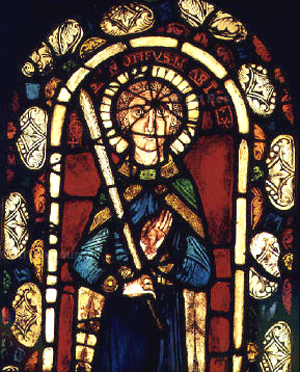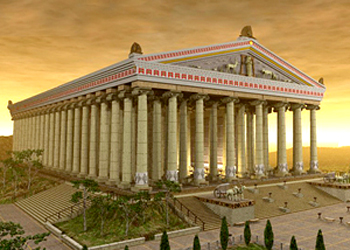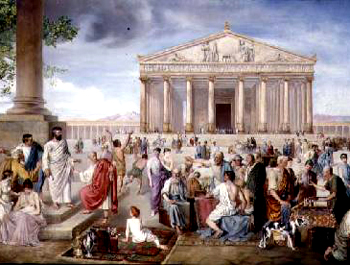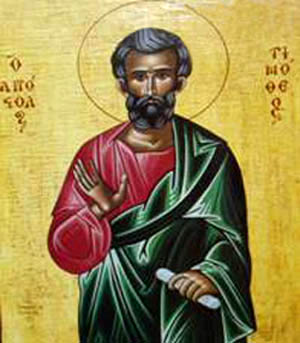 |
The Saint of the Day
St. Timothy – January 24
Prof. Plinio Corrêa de Oliveira
Biographical selection:
Timothy was born in Lystra in Lycaenia, present day Turkey. His father was a Gentile and his mother, a Jew. As a youth St. Timothy was converted by St. Paul when he came to Lystra. Seven years later, St. Paul returned and took him as a companion on his journey.

St. Timothy - Abbey of Neuwiller, Alsace, 12th century
|
Eventually St. Paul made Timothy the first Bishop of Ephesus in order to govern that church. It was there that he received the two Epistles by St. Paul, one written from Macedonia and the second from Rome, to direct him in his pastoral needs.
Timothy could not bear that the people of Ephesus offered the devils that inhabited the idols a sacrifice due only to God. On a feast day of the goddess Diana, he entered into the crowd who were worshipping the goddess, and exhorted the people to renounce their idolatry and embrace Jesus Christ. Infuriated, the people turned on him and stoned him. The Christians of the city transported him half-dead to a mountain, where he expired.
Catherine Emmerick adds to these data that Timothy was tall, thin, and pale with dark hair; he was greatly loved by the Catholics. In Ephesus he fought relentlessly against the disordered revelries and orgies that took place often to celebrate the idols. This was the cause of his death.
Comments of Prof. Plinio:
The first thing that catches one’s attention in this description is the courage of St. Timothy.
The temple of Diana in Ephesus was one of the most famous monuments of antiquity. It was considered one of the Seven Wonders of the Ancient World. I have seen reproductions of this temple and it was, indeed, very beautiful. It was an enormous temple constructed of white marble that sat atop an ensemble of monumental stairs surrounding the edifice. The ceiling was very high and in proportion to the other parts of the building.
A large statue of Diana stood within. Today some art critics complain that its architecture was not purely Greek in style, but was mixed with some Eastern elements. I do
not see that this would detract from its great beauty.

The temple of Diana in Ephesus.
Below, people gathering in front of the temple

|
The goddess Diana, or better said the devil that possessed the idol, worked all kinds of extraordinary acts and marvelous phenomena to impress the people of Ephesus, which helped to spread Diana’s fame and sustain the popularity of idolatry.
By going to the temple and trying to stop the worship there, St. Timothy manifested an extraordinary courage and a remarkable capacity to face the enemy. Because of this, he was stoned and died.
Facing evil and error head on, he took a position of frontal and public attack, with full knowledge of all the inconveniences that could follow, as in fact they did. He did not care about these consequences; he chose to immolate himself for the glory of God by dying in this way.
Should we always face the enemy in a frontal attack? Or should we at times take this tactic, and at other times face the enemy with astuteness, maneuvering to lead him into a trap, and then win the battle?
Many times, in the life of the saints, they have a divine inspiration to act in an extraordinary way. Their actions are certainly meant to inspire us and to be admired, but not necessarily to be imitated.
For example, consider the famous case of St. Francis of Assisi quarreling with his father, Pietro di Bernardone. His father opposed the decision of Francis to dedicate his life to religion. He argued that everything Francis had was due to his work and efforts and therefore, Francis was obliged to his advice. Even the clothing Francis was wearing was owed to him, Bernardone argued.
In response, St. Francis took off his fine garments and told his father “Take your clothes, then. I will go without them … ” And he went away almost naked.
This episode does not mean that every person who fights with his father or mother for similar reasons should take off his clothes and walk away
half nude. It is an episode that should inspire us to maintain the ideal of the vocation God gave us, even when our families or friends oppose it. We should be inspired to have a similar strength, not to repeat the same action.

St. Timothy |
So, regarding the episode of St. Timothy, it should inspire us to be as audacious as possible against our enemies. It is an invitation to never step back from our enemies.
In this sense it could very well be seen as an inspiration for the vow of the Templar knights: To never retreat in battle. It is also an inspiration for all who combat for the Faith to never make any concession to evil, even when it gives us prestige, fame or popularity.
We should face the evil and fight to destroy it – with the price of our lives if necessary. We can be sure that Our Lord will reward us for that, as he rewarded St. Timothy, giving him the honor and veneration of all Catholics throughout the centuries in History, and more than that, eternal glory in Heaven.
Notwithstanding this lesson and inspiration from the last combat of St. Timothy, sometimes in our fight we need to use other methods, depending on the circumstances. At times, we should imitate the audacity of St. Timothy walking straight up to the idol to destroy it and drive away its audience. At other times, we have to wait for the right moment to come, and then attack.
Let us ask St. Timothy to give us audacity when it is for the greater glory of God, and also
the discernment to know when to use audacity and when to use prudence in order to take and destroy the enemy later.


  | | Prof. Plinio Corrêa de Oliveira | |
The Saint of the Day features highlights from the lives of saints based on comments made by the late Prof. Plinio Corrêa de Oliveira. Following the example of St. John Bosco who used to make similar talks for the boys of his College, each evening it was Prof. Plinio’s custom to make a short commentary on the lives of the next day’s saint in a meeting for youth in order to encourage them in the practice of virtue and love for the Catholic Church. TIA thought that its readers could profit from these valuable commentaries.
The texts of both the biographical data and the comments come from personal notes taken by Atila S. Guimarães from 1964 to 1995. Given the fact that the source is a personal notebook, it is possible that at times the biographic notes transcribed here will not rigorously follow the original text read by Prof. Plinio. The commentaries have also been adapted and translated for TIA’s site.
|
Saint of the Day | Home | Books | CDs | Search | Contact Us | Donate

© 2002- Tradition in Action, Inc. All Rights Reserved
|
 |
|